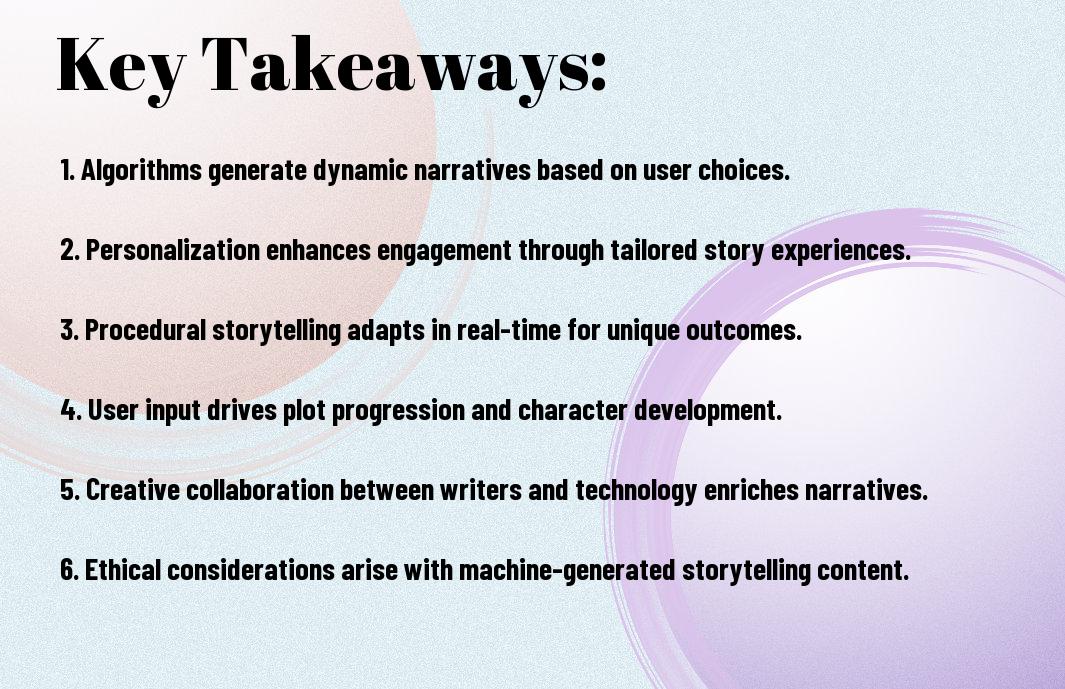As you explore into the world of dynamic narratives, you’ll discover that procedural storytelling is revolutionizing the way stories are told. You’re likely familiar with the concept, but may not know its full potential. Procedural storytelling is exploding the possibilities of game development and interactive media, allowing your experiences to be unique and immersive. Your understanding of this concept will help you appreciate the innovative ways algorithms are shaping your entertainment.
Key Takeaways:
- Procedural storytelling allows for the creation of dynamic, adaptive narratives that can change based on player input or other variables, offering a unique experience each time the story is engaged with.
- Algorithms can generate story elements such as characters, plot twists, and environments, enabling the production of vast, detailed worlds without the need for manual writing of every detail.
- This approach enables game developers and storytellers to create immersive, interactive stories that respond to the actions and decisions of the audience, enhancing engagement and replay value.
- Procedural storytelling can also facilitate the creation of stories that are tailored to individual players, incorporating their preferences, playstyle, and previous experiences into the narrative.
- The use of algorithms in storytelling can lead to unexpected and innovative narrative developments, as the machine learning process can combine elements in ways that human writers might not consider.
- However, procedural storytelling also poses challenges, such as ensuring coherence and consistency in the generated narrative, and balancing algorithmic creativity with the need for a compelling, meaningful story.
- The integration of procedural storytelling techniques into various forms of media, including video games, films, and literature, has the potential to revolutionize the way stories are created and experienced, offering new possibilities for interactive and dynamic narrative design.
Foundations of Procedural Storytelling
A key aspect of procedural storytelling is its ability to generate unique narratives based on algorithms and user input, allowing you to experience a different story each time you engage with the system.
Algorithm-Based Narrative Systems
Behind the scenes of procedural storytelling lies a complex system of algorithms that work together to create a cohesive narrative, enabling you to explore a wide range of possibilities and storylines.
Core Components of Digital Storytelling
Digitally-driven narratives rely on several core components, including character development, plot progression, and user interaction, which you can manipulate to create a personalized story that suits your interests and preferences.
Indeed, as you probe deeper into the world of procedural storytelling, you will discover that the core components of digital storytelling are highly interconnected, allowing you to influence the narrative through your choices and actions, and creating a unique experience that is tailored to your individual perspective.

Narrative Generation Mechanics
Even as you examine into the world of procedural storytelling, you’ll notice that algorithms play a significant role in generating narratives. These mechanics enable the creation of unique stories, tailored to your preferences, and can be used in various forms of media, from video games to interactive books.
Pattern Recognition in Story Elements
Across various narrative structures, you’ll find that pattern recognition is key to creating engaging stories. You’ll see how algorithms identify and replicate patterns in story elements, such as character arcs and plot twists, to craft compelling narratives that draw you in.
Dynamic Plot Construction
Behind the scenes, dynamic plot construction enables the creation of adaptive stories that change based on your interactions. You’ll experience a unique narrative that evolves as you make choices, influencing the story’s direction and outcome.
And as you explore dynamic plot construction further, you’ll discover that it involves complex algorithms that analyze your decisions and adjust the narrative accordingly. This allows you to become an active participant in the storytelling process, shaping the story into a unique experience that reflects your preferences and actions.

Character Development Through Code
After implementing procedural storytelling, you can create complex characters using code, allowing for dynamic and immersive experiences. You can define character traits, backstories, and motivations, and then use algorithms to generate unique personalities and behaviors.
AI-Driven Personality Matrices
Prior to creating your characters, you’ll need to establish a framework for their personalities, which can be achieved through AI-driven personality matrices. You’ll use these matrices to define the characteristics and traits that shape your characters’ interactions and decisions.
Behavioral Response Systems
By designing behavioral response systems, you can create characters that react and adapt to your actions, making the story feel more responsive and engaging. You’ll use these systems to determine how characters respond to different situations, creating a more immersive experience.
Behavioral response systems allow you to craft characters that learn and grow based on your interactions, enabling a deeper connection between you and the story. As you progress through the narrative, you’ll notice characters adapting to your choices, creating a unique experience tailored to your decisions, and allowing you to feel more invested in the story and its outcomes.
World Building Parameters
All procedural storytelling systems rely on a set of predefined parameters that define the world in which your narrative takes place. You will need to establish these parameters to create a cohesive and engaging story. This includes defining the physical world, its rules, and the characters that inhabit it.
Environmental Variable Management
Besides the physical aspects, you must also consider the environmental variables that will affect your story, such as climate, time of day, and weather. You will need to manage these variables to create a believable and immersive world.
Dynamic Setting Adaptation
Setting the stage for your story is necessary, and dynamic setting adaptation allows you to create a world that changes and evolves over time. You can use algorithms to generate new environments, characters, and events, keeping your story fresh and exciting.
World builders like yourself can use dynamic setting adaptation to create a unique experience for your audience. You can generate new content on the fly, allowing your story to unfold in unexpected ways. This approach enables you to create a highly engaging and interactive narrative, where your audience is an active participant in the storytelling process.
Player Interaction Integration
To create a seamless procedural storytelling experience, you need to integrate player interaction into the narrative. This involves designing a system that responds to your actions, creating a dynamic and immersive story.
Choice Architecture
Against the backdrop of a procedurally generated world, you are presented with choices that shape the narrative. You must consider how your decisions will impact the story, making each choice a deliberate and meaningful one.
Consequence Mapping
With every decision you make, the story unfolds in a unique way, influenced by the consequences of your actions. You begin to see the effects of your choices, and the narrative adapts to your playstyle.
Consequence mapping allows you to visualize the potential outcomes of your decisions, enabling you to make informed choices that drive the story forward. As you navigate the procedural narrative, you will encounter multiple branching paths, each leading to a distinct conclusion, and you must use your wits to navigate the complex web of consequences that arise from your actions.
Technical Implementation
Many procedural storytelling systems rely on complex algorithms and data structures to generate narratives. As you probe into the technical aspects, you’ll find that the implementation can vary greatly depending on your goals and requirements.
Story Engine Architecture
Around the core of procedural storytelling lies the story engine, which you will design to manage and generate your narrative. As you build your engine, you’ll need to consider factors such as character development, plot progression, and player interaction.
Data Structure for Narratives
At the heart of your story engine is the data structure that stores and organizes your narrative elements. As you design this structure, you’ll want to consider how you can efficiently store and retrieve the vast amounts of data that will drive your story.
The data structure you choose will have a significant impact on the performance and scalability of your procedural storytelling system. You’ll need to consider factors such as data compression, indexing, and querying to ensure that your system can handle the complex narratives you’ll be generating. As you work on your data structure, you’ll find that a well-designed system will allow you to create rich, immersive stories that draw your players in and keep them engaged.
Final Words
Drawing together the concepts of procedural storytelling, you now have a deeper understanding of how algorithms shape your narrative experiences. As you explore the world of procedural narrative, you can learn more about its applications at Procedural Narrative: The Future of Video Games, and discover how your favorite games use these techniques to create unique stories, enhancing your engagement and immersion in the gaming world, and influencing your perception of your role in the narrative.
FAQ
Q: What is Procedural Storytelling and how does it differ from traditional storytelling methods?
A: Procedural Storytelling refers to the use of algorithms and computational methods to generate narrative content, such as stories, dialogue, or even entire games. This approach differs significantly from traditional storytelling, where a human author manually crafts every detail. In procedural storytelling, the algorithm creates the narrative on the fly, using a set of predefined rules and parameters. This allows for a high degree of variability and replayability, as the story can change each time it is generated. Procedural storytelling has applications in various fields, including video games, interactive fiction, and even film and television production.
Q: How do algorithms actually generate narrative content in Procedural Storytelling, and what are the limitations of this approach?
A: Algorithms in procedural storytelling use a combination of natural language processing, machine learning, and data analysis to generate narrative content. They can analyze existing stories, identify patterns, and then use this information to create new narratives based on a set of rules or constraints. However, the limitations of this approach include the potential lack of depth and emotional resonance in the generated stories, as well as the risk of repetition or inconsistency. Additionally, the quality of the output is highly dependent on the quality of the input data and the sophistication of the algorithm itself. Despite these limitations, procedural storytelling has the potential to create unique and engaging narrative experiences that can adapt to individual players or viewers.
Q: What are the potential applications and future developments of Procedural Storytelling, and how might it change the way we consume and interact with narrative content?
A: The potential applications of procedural storytelling are vast and varied, ranging from the creation of personalized interactive stories and games to the generation of dynamic dialogue and characters in film and television. Future developments in this field may include the integration of procedural storytelling with virtual and augmented reality technologies, allowing for even more immersive and interactive narrative experiences. As procedural storytelling continues to evolve, it may change the way we consume and interact with narrative content, enabling new forms of dynamic and adaptive storytelling that can respond to individual preferences and behaviors. This could potentially democratize the storytelling process, allowing new voices and perspectives to emerge, and creating new opportunities for innovative and engaging narrative experiences.


